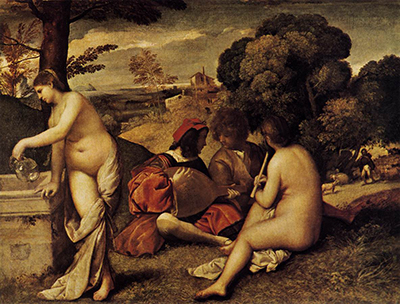Many of Giorgione's paintings have been the subject of controversy, but none more so than Pastoral Concert.
Painted c. 1509, the work was originally attributed to Giorgione, however, after much consternation, many modern scholars believe it may well be a work by Titian. Known also as Fête champêtre or Le Concert champêtre, Pastoral Concert can be found today hanging in The Louvre in Paris.
For many years is was believed that Pastoral Concert was a work by Giorgione. Later, when scholars examined the painting more closely, it was considered that this was, like The Sleeping Venus a collaboration with Titian; started by Giorgione and then finished by Titan after his death in 1510. However, due to the shape of the nude figures, modern experts now believe that it was, in fact, an early work of Titian alone.
Over the years scholars have hotly debated the attribution of “Pastoral Concert”. In addition to Giorgione and Titian, it has been also been suggested that Palma the Elder or even Sebastiano del Piombo could have been the authors. While this may all seem very haphazard, there is a simple explanation for the confusion.
All of these remarkable artists were members of the Venetian School, founded by the great Bellini and his students. Early 16 th century Venice was a hive of artistic innovation and experimentation. Inspired by the high renaissance painters such a Leonardo da Vinci, these men explored the world of colour, light and shade as Columbus explored the New World.
As a result, they copied and influenced one another, collectively, developing skills and techniques that set them apart. They created a signature style for the school which they all used. This style makes the artists of the venetian school very difficult for modern scholars to tell apart. Therefore, as it is clear that Titian’s style was very much informed by his admiration for Giorgione’s talent, it is hard to determine whether Titian finished Giorgione’s original work, or if “Pastoral Concert” was his own composition.
Pastoral Concert is widely considered to symbolise poetry and all its beauty. The scene depicts four main figures; two clothed men sitting on the grass, and two nude women, one standing, pouring water into a fountain and the other sitting with the men playing a flute. They are in a beautiful sun-lit landscape and in the background, there is a shepherd tending his flock. The composition seems a little strange, but it is assumed that the presence of the young women is more imaginary than real, and the young men are the only ones who can see them. Painting the visions of imagination was very popular with Venetians of the time.
As with most of Giorgione’s works, the meaning of Pastoral Concert is much debated. The presence of the flute and the vase of water as symbols of pastoral and tragic prose respectively, make it plain that we are looking at an allegory of poetry, and this aspect of the painting is undisputed. However, there are other elements of Pastoral Concert that offer different interpretations.
There are several theories as to who the people represent. Some scholars have considered that the women are nymphs of the water and woodland drawn to visit the men as they relax and enjoy the peace and beauty around them. Others believe that the women are the embodiment of the young men’s ideal of beauty. Either argument could be feasible as the men appear to be unaware of the women; even though they are very near and nude, they are not looking at them.
There are still further arguments that the painting is an allegory for the four elements of nature; earth, fire, wind and water. The peace and concord of the gathering would symbolise the harmony of nature. This theory, though simplistic, could be close to the truth as Giorgione was a great aficionado of nature and all her exquisite forms.
Perhaps the most common translation of “Pastoral Concert” is that it is a pictorial description of pastoral poetry and the harmony it brings to the soul. This type of poetry, which has its root in ancient Greece and Rome, was a prevalent theme for paintings in Renaissance Europe. The idea of Gods and Goddesses sending muses and nymphs to inspire mere mortals with their music and song was an inspiration to many, commoner and aristocrat alike. Indeed, fellow venetian, Jacopo Sannazaro’s poem, Arcadia could well have influenced Giorgione’s subject matter.
Although not the first painting to depict this poetic subject matter, it is most certainly considered to be one of the greatest and most inspiring. The use of colour and shade to create the emotions of joy and contentment are indicative of the techniques and skills most evident in Giorgione’s work and in the venetian school in general. Not only did this work inspire artists of the time, but it is said that Manet himself was stirred to create his wonderful Le déjeuner sur l'herbe over 300 years later in 1863, after viewing “Pastoral Concert” in the Louvre.




